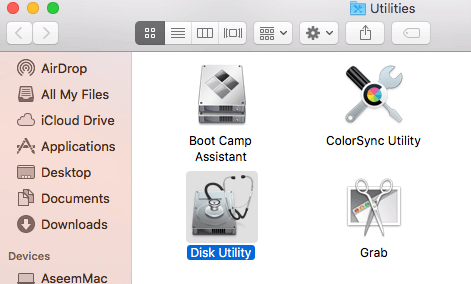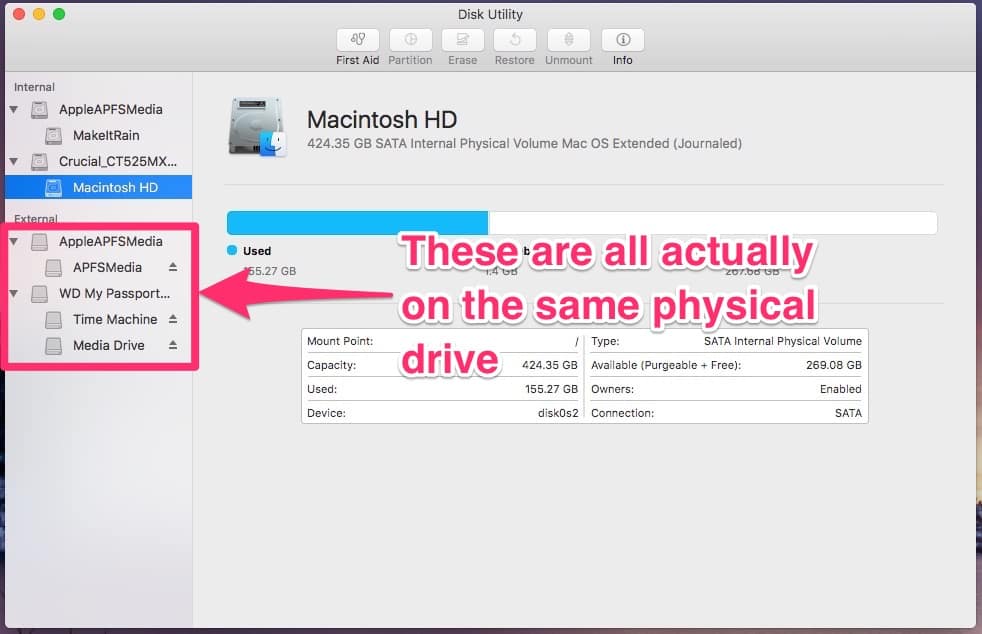- Disk Utility cannot find my internal drive after many days of trying and trying out. Do you have any utility to create HFS file – just like yours (install images.
- The trick to get Disk Utility to reformat an APFS drive as HFS+ is that you first have to remove all the APFS partitions from the drive. Once all APFS partitions/volumes are gone, then it should allow you to reformat the drive as HFS+. I used the following steps in Disk.
- Hfs Disk Utility Disk
- Disk Utility Journaling Hfs
- Hfs Disk Utility Manager
- Hfs Disk Utility Equipment
- Disk Utility Hfs
Summary:This article shows you two risk-free ways to revert/convert APFS to HFS/HFS+.And if unfortunately you lose data after changing APFS to HFS/HFS+, don't feel panicked, just downloadiBoysoft Data Recovery for Mac to recover files with ease.
In the Disk Utility app on your Mac, select an existing APFS volume in the sidebar, then click the Add Volume button in the toolbar. If Disk Utility isn't open, click the Launchpad icon in the Dock, type Disk Utility in the Search field, then click the Disk Utility icon. Enter a name for the new APFS volume. HFS Utilities HFS is the 'Hierarchical File System,' the native volume format used on modern Macintosh computers. Hfsutils is the name of a comprehensive software package being developed to permit manipulation of HFS volumes from UNIX and other systems. Simple and easy to use, MacDrive is recognized as the leader for accessing Mac disks from Windows for almost 20 years. Once you plug in your Mac disk, behind the scenes MacDrive works to seamlessly enable Windows understand HFS+ disks and allow you to read and write to the disk.
I'm deciding to install MacOS High Sierra on my Mac this autumn. So, if I find APFS not useful, is it possible to convert APFS back to HFS+ via terminal or using Disk utility?
If you upgrade to macOS Catalina Big Sur 11, 10.15, Mojave 10.14 or High Sierra 10.13, the solid-state drive (SSD) will be automatically converted from HFS/HFS+ to APFS and there is no opt-out. However, even though the APFS file system is optimized for HFS+ with many advanced properties, many Mac users cannot get used to APFS and want to convert APFS back to HFS+. It is undeniable that APFS does come with some limitations and brings users troubles like drive corruption after converting from HFS+ to APFS.
Then you may ask, is it possible to convert/revert APFS back to HFS/HFS+? The answer is 'Yes' but with some precautions. This page will list what you should know when you revert or convert APFS to HFS/HFS+ and provide the details about the best APFS to HFS converter with no risk of losing data.

- Table of contents
- 1. Notes on converting APFS to HFS/HFS+
- 2. How to revert/convert APFS to HFS+
- 3. How to recover lost data after reverting/converting APFS to HFS+?
- 4. Conclusion
Notes on converting APFS to HFS/HFS+
First, as you may have noticed, there is a new concept called container in APFS. A container is the basic storage unit for APFS and each APFS container contains one or more APFS volumes. One of these APFS volumes will have macOS and each volume could have different APFS type: APFS, APFS (Encrypted), APFS (Case-sensitive) or APFS (Case-sensitive, Encrypted). As a result, there are some rules when you convert APFS to HFS/HFS+:
Allowed: convert APFS container to HFS+ (also named Mac OS Extended)
Not allowed: convert a single APFS volume to HFS+
Not allowed: convert APFS to HFS
Hfs Disk Utility Disk
What's more, you need to know that converting APFS back to HFS+/HFS will format your SSD and erase all data on it. Thus, please make sure you have a backup copy of the APFS container or the whole drive. If you already backed up your data on this SSD drive, read Part 1 to learn details about how to convert/revert APFS back to HFS. Nevertheless, if you have lost something important when you convert APFS to HFS+, you can skip to Part 2 to recover lost data after the conversion from APFS to HFS+.
How to revert/convert APFS to HFS+?
Method 1: Convert APFS to HFS+ in Disk Utility
Disk Utility is a built-in tool that can manage internal and external storage devices, including partitioning and formatting your disks, creating disk image, checking and repair disk errors, etc. So, you can convert APFS to Mac OS Extended (HFS+) with this natural APFS to HFS+ converter - Disk Utility.
Attention: This process is destructive to your data on the APFS container/drive. So please check again if you have a backup copy.
Step 1: Go to Applications > Utilities > Disk Utility.
Step 2: Select the drive that you want to convert/revert from APFS to HFS+.

- Table of contents
- 1. Notes on converting APFS to HFS/HFS+
- 2. How to revert/convert APFS to HFS+
- 3. How to recover lost data after reverting/converting APFS to HFS+?
- 4. Conclusion
Notes on converting APFS to HFS/HFS+
First, as you may have noticed, there is a new concept called container in APFS. A container is the basic storage unit for APFS and each APFS container contains one or more APFS volumes. One of these APFS volumes will have macOS and each volume could have different APFS type: APFS, APFS (Encrypted), APFS (Case-sensitive) or APFS (Case-sensitive, Encrypted). As a result, there are some rules when you convert APFS to HFS/HFS+:
Allowed: convert APFS container to HFS+ (also named Mac OS Extended)
Not allowed: convert a single APFS volume to HFS+
Not allowed: convert APFS to HFS
Hfs Disk Utility Disk
What's more, you need to know that converting APFS back to HFS+/HFS will format your SSD and erase all data on it. Thus, please make sure you have a backup copy of the APFS container or the whole drive. If you already backed up your data on this SSD drive, read Part 1 to learn details about how to convert/revert APFS back to HFS. Nevertheless, if you have lost something important when you convert APFS to HFS+, you can skip to Part 2 to recover lost data after the conversion from APFS to HFS+.
How to revert/convert APFS to HFS+?
Method 1: Convert APFS to HFS+ in Disk Utility
Disk Utility is a built-in tool that can manage internal and external storage devices, including partitioning and formatting your disks, creating disk image, checking and repair disk errors, etc. So, you can convert APFS to Mac OS Extended (HFS+) with this natural APFS to HFS+ converter - Disk Utility.
Attention: This process is destructive to your data on the APFS container/drive. So please check again if you have a backup copy.
Step 1: Go to Applications > Utilities > Disk Utility.
Step 2: Select the drive that you want to convert/revert from APFS to HFS+.
Step 3: Click Erase on the top of the Disk Utility window.
Step 4: Complete the required name, select Mac OS Extended (HFS+) as the new format and then click the Erase button.
Lightroom customer service. When the process finishes, you'll get a clean HFS+ formatted drive and you can then copy back your data.
Method 2: Convert APFS to HFS+ with Terminal
The Command line, or known as Terminal in macOS, is a powerful, text-only method for interacting with your Mac computer. If you are an experienced Mac user, using macOS's built-in command line would be an appealing way to convert/revert APFS to HFS+.
Step 1: Go to Applications > Utilities > Terminal.
Step 2: Type diskutil list and find the identifier of the APFS container.
Step 3: Typediskutil eraseDisk JHFS+ 'the disk name' /dev/'the identifier'. This process will wipe all the files in this APFS container and convert it back to APFS.
How to recover lost data after reverting/converting APFS to HFS+?
If you get into problems during the process of converting APFS to HFS+/HFS, such as HFS+ partition corruption, or have lost data due to mistaken APFS to HFS+ conversion, you can recover lost data with iBoysoft Data Recovery for Mac.
iBoysoft Data Recovery for Mac is thebest APFS data recovery software that can recover files after failing to convert APFS to HFS+, convert HFS to APFS, recover deleted/lost data from APFS volumes,recover lost data from formatted APFS drives, recover lost data from unmountable APFS drives, recover lost data from inaccessible APFS drives, recover lost data from corrupted APFS drives, recover deleted/lost APFS volumes, etc.
Step 1: Launch iBoysoft Data Recovery for Mac.
Step 2: Choose the drive that you lost files when you converted from APFS to HFS+, click 'Next' to scan for lost files on it.
Step 3: Double-click to preview the searching results and make sure the data integrity.
Step 4: Choose files you want to get back, click 'Recover' and save them.
Except for APFS data recovery, iBoysoft Data Recovery for Mac also performs effective and reliable data recovery from drives formatted with other file systems (such as HFS, HFS+, FAT32 and exFAT), as well as data recovery from formatted, unreadable, unmountable, corrupted hard drives, external hard drives, memory cards, USB drives, Pen drives, etc. It's fully compatible with macOS Big Sur 11/10.15/10.14/10.13/10.12 and Mac OS X 10.11/10.10/10.9/10.8/10.7.
Conclusion
The newest default APFS for macOS Catalina/Mojave/High Sierra and later is not necessarily the best for Mac users. If you need to downgrade APFS to HFS+/HFS without data loss, backing up your data and reformatting your drive is always the safest choice, while if you are interested in new features in APFS, you can also convert HFS to APFS on Mac.
Still have questions?
A free and open-source command line utility specially designed to help you read Mac-formatted hard disks and disk images from a Terminal window
What's new in HFSExplorer 0.23.1:
- Bug fix: Fix support for encrypted images with the version 2 header and multiple key entries.
- Bug fix: Help content could not be located due to a recent location change.
- Enhancement: Use the same custom icon for all HFSExplorer windows, making them easier to find.
- Enhancement: Attempt to force the GTK+ Look & Feel if the default one provided by the system is Metal or Motif. This makes HFSExplorer more usable in superuser mode on many Linux distributions.
Disk Utility Journaling Hfs
Read the full changelogHfs Disk Utility Manager
HFSExplorer is a straightforward OS X utility capable of reading the HFS+ (Mac OS Extended), HFS (Mac OS Standard) and HFSX (Mac OS Extended with case sensitive file names) file systems.
By using HFSExplorer, you can browse your Mac's volumes, extract and copy files, create disk images and view detailed information about a volume of your choice.
Hfs Disk Utility Equipment
On top of that, HFSExplorer provides the necessary tools to read AES-128 encrypted images, DMG disk images, as well as, ZLIB and BZIP2 compressed images.
In addition, HFSExplorer comes with support for the Apple Partition Map, GUID Partition Table and Master Boot Record partition schemes.
HFSExplorer proves its utility, if you need to access files on the Mac OS X hard driver from Windows, the content from your HFS+ formatted iPod or DMG disk image.
The HFSExplorer utility is a cross-platform software that can be used on Mac OS X, Linux and Windows.
Filed under
This enables Disqus, Inc. to process some of your data. Disqus privacy policyHFSExplorer 0.23.1
add to watchlistsend us an updateDisk Utility Hfs
- runs on:
- Mac OS X (PPC & Intel)
- file size:
- 1.6 MB
- main category:
- System Utilities
- developer:
- visit homepage
top alternatives FREE
top alternatives PAID

